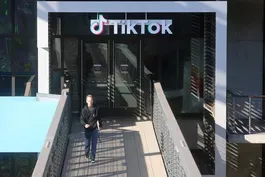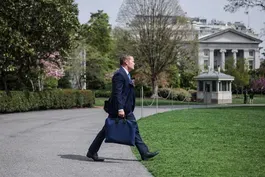
How NCAA's transfer portal transformed March Madness
Clip: 4/4/2025 | 6m 8sVideo has Closed Captions
How NCAA's transfer portal transformed March Madness
The NCAA Women’s Final Four tips off Friday in Tampa Bay with the men’s games starting Saturday in San Antonio. This year, the tournaments are unique because they feature a large number of players who previously played for a different school. That’s thanks to rule changes that let athletes easily move between schools. William Brangham discussed more with Jesse Dockerty of The Washington Post.
Problems with Closed Captions? Closed Captioning Feedback
Problems with Closed Captions? Closed Captioning Feedback
Major corporate funding for the PBS News Hour is provided by BDO, BNSF, Consumer Cellular, American Cruise Lines, and Raymond James. Funding for the PBS NewsHour Weekend is provided by...

How NCAA's transfer portal transformed March Madness
Clip: 4/4/2025 | 6m 8sVideo has Closed Captions
The NCAA Women’s Final Four tips off Friday in Tampa Bay with the men’s games starting Saturday in San Antonio. This year, the tournaments are unique because they feature a large number of players who previously played for a different school. That’s thanks to rule changes that let athletes easily move between schools. William Brangham discussed more with Jesse Dockerty of The Washington Post.
Problems with Closed Captions? Closed Captioning Feedback
How to Watch PBS News Hour
PBS News Hour is available to stream on pbs.org and the free PBS App, available on iPhone, Apple TV, Android TV, Android smartphones, Amazon Fire TV, Amazon Fire Tablet, Roku, Samsung Smart TV, and Vizio.
Providing Support for PBS.org
Learn Moreabout PBS online sponsorshipAMNA NAWAZ: The NCAA women's Final Four tips off tonight in Tampa, with the men's last game starting tomorrow in San Antonio.
William Brangham has a look now at the ways in which the games are shifting -- William.
WILLIAM BRANGHAM: Amna, this year's tournaments are unique in part because they feature a large number of players who previously played for a different school.
That's thanks to big rule changes in the NCAA that let athletes easily move between schools.
So to help break all this down and explain the broader impact on college sports, we are joined by Jesse Dougherty.
He's a reporter at The Washington Post who covers the business of sports.
Jesse, thank you so much for being here.
Help us understand the big changes that are under way now with athletes able to enter what is called the so-called transfer portal, which allows them to toggle between schools.
How is that impacting the game and more specifically this tournament?
JESSE DOUGHERTY, The Washington Post: Yes, the reasons for it are really twofold.
On one side, there's the transfer portal piece, and then very, very interconnected, there's name, image, and likeness money, which we more colloquially refer to as NIL.
So about three, four years ago, the NCAA started to loosen transfer rules.
At the same time, they allowed athletes to start monetizing their name, image, and likeness, effectively get paid, whether by brands or boosters.
And what happened is that basically, annually, athletes started switching schools, because now the NCAA have far fewer restrictions on needing to sit out or needing to sort of spend time away from the game when you did switch programs, and, at the same time, being able to make that NIL money, programs started bidding on these players, sort of like free agents in professional sports.
So that's all culminated in an era of extreme player movement, which has affected both the men's and women's brackets.
On the men's side, for example, more than half the players in this year's 68-team tournament field had played for a previous D1 team before this season.
And it's just an astounding number.
So, really, I mean, for the fans, it's just -- it's hard to follow the arc of players and teams like you maybe once did because players are so often switching schools, going somewhere else, finding more playing time, finding a better fit, making more money in a lot of cases.
And it's just -- it's created a sort of transactional nature of the sport.
WILLIAM BRANGHAM: If it has created that somewhat, as some argue, a Wild West atmosphere, what is the rationale for this -- for the portal that allows this jumping back and forth?
JESSE DOUGHERTY: Yes, the rationale is that anyone can change jobs this frequently.
I mean, you and I could change companies once a year.
We probably wouldn't want to do that.
But the reality here is that the market has decided that these athletes are worth a lot of money.
And for decades, they were not able to make that money.
It was -- it was, frankly, suppressed by NCAA rules.
And now seeing that this market has responded to say, you're worth $400,000, $600,000, over a million every year, these athletes are never more valuable.
They're never more able to monetize on that talent than when they're available.
So that sort of created this transfer portal.
So the rationale is more of a free market argument.
There's not really one that sort of, I think, is conducive to upping fan interest or necessarily promoting that sort of academic path through college.
But in terms of just sort of how professional sports operate, in this case, it's about a free market as any.
I mean, NFL, NBA, MLB players, they all need to stay on teams for multiple years, if not sometimes close to a decade in some cases.
And these college players have really had free rein just to move as much as possible.
WILLIAM BRANGHAM: I mean, I have got to imagine, if I were a coach of a team, that this has got to be a complicated thing, knowing that somebody who I had trained and brought up and thought, OK, you're a sophomore now, you're going to be great your junior and senior years, now that person could be gone.
I mean, how are coaches responding to this?
JESSE DOUGHERTY: Some prominent ones have retired and cited this as a reason, not the sole reason, but Tony Bennett at Virginia, Jay Wright at Villanova, Jim Larranaga at Miami this year mid-season just saying they can't quite get into this new era.
They can't meet the demands that we need to do on top of coaching.
I mean, now you're sort of an around-the-clock fund-raiser, negotiator, the G.M.
in a lot of cases.
So, coaches are having trouble in some schools in instances of adapting.
Others who are older, whether it's Rick Pitino, some others are adapting well and sort of taking to the new era and using a lot of the tools and new ways to roster build and just leaning in, so to speak.
So, there's a range of reactions.
I mean, there's some like Tom Izzo at Michigan State who didn't really use the transfer portal for this year's roster.
And he had -- went all the way to the Elite Eight, one win from the Final Four.
So there's not really one way to do this.
There's -- frankly, there's thousands probably if you broke down all the different permutations to build a roster, but the coaching community certainly would like more structure.
I don't think they prefer to have the transfer portal open during the tournament and spend this time of the year, when they just finished up a whole season recruiting a whole new roster, worrying about retaining their players.
I mean, it certainly added a lot more layers to the process.
And I think coaching in a lot of ways is not what these guys are used to or what they initially signed up for.
WILLIAM BRANGHAM: Right.
In the last 30 seconds or so we have, are there efforts to regulate this?
I know there's a big hearing next week.
Can you just briefly describe what's going on there?
JESSE DOUGHERTY: Yes, starting this summer, schools will be able to -- will likely be able to directly pay athletes for the first time.
To this point, it's really only been boosters and brands.
So with that, there will come a salary cap if that does happen.
A major legal settlement has to happen first, but that would provide some regulation, some spending guidelines.
The NCAA hopes to limit booster spending in the future.
It remains to be seen if that will all be successful, but there are certainly efforts under way to try to bring some regulation and structure to this industry.
WILLIAM BRANGHAM: All right, Jesse Dougherty of The Washington Post, thank you so much for joining us.
JESSE DOUGHERTY: Thank you for having me.
Brooks and Capehart on political reaction to Trump's tariffs
Video has Closed Captions
Brooks and Capehart on the political reaction to Trump's tariffs (10m 17s)
Fired federal workers struggling to land new jobs
Video has Closed Captions
Fired federal workers struggling to land new jobs in tightening white-collar sector (6m 44s)
Kennedy Center at a crossroads as it's pulled into politics
Video has Closed Captions
Kennedy Center faces a crossroads as it's pulled into partisan politics (9m 4s)
News Wrap: Trump gives TikTok more time to find U.S. buyer
Video has Closed Captions
News Wrap: Trump gives TikTok another 75 days to find American buyer to keep app running (6m 19s)
Trade war and tariffs drag markets to worst week in years
Video has Closed Captions
Trade war, tariffs and uncertainty drag markets to worst week in years (6m 59s)
Trump shakes up NSA amid pressure from right-wing activist
Video has Closed Captions
Trump abruptly shakes up NSA leadership amid pressure from right-wing activist (5m 52s)
Providing Support for PBS.org
Learn Moreabout PBS online sponsorshipSupport for PBS provided by:
Major corporate funding for the PBS News Hour is provided by BDO, BNSF, Consumer Cellular, American Cruise Lines, and Raymond James. Funding for the PBS NewsHour Weekend is provided by...













